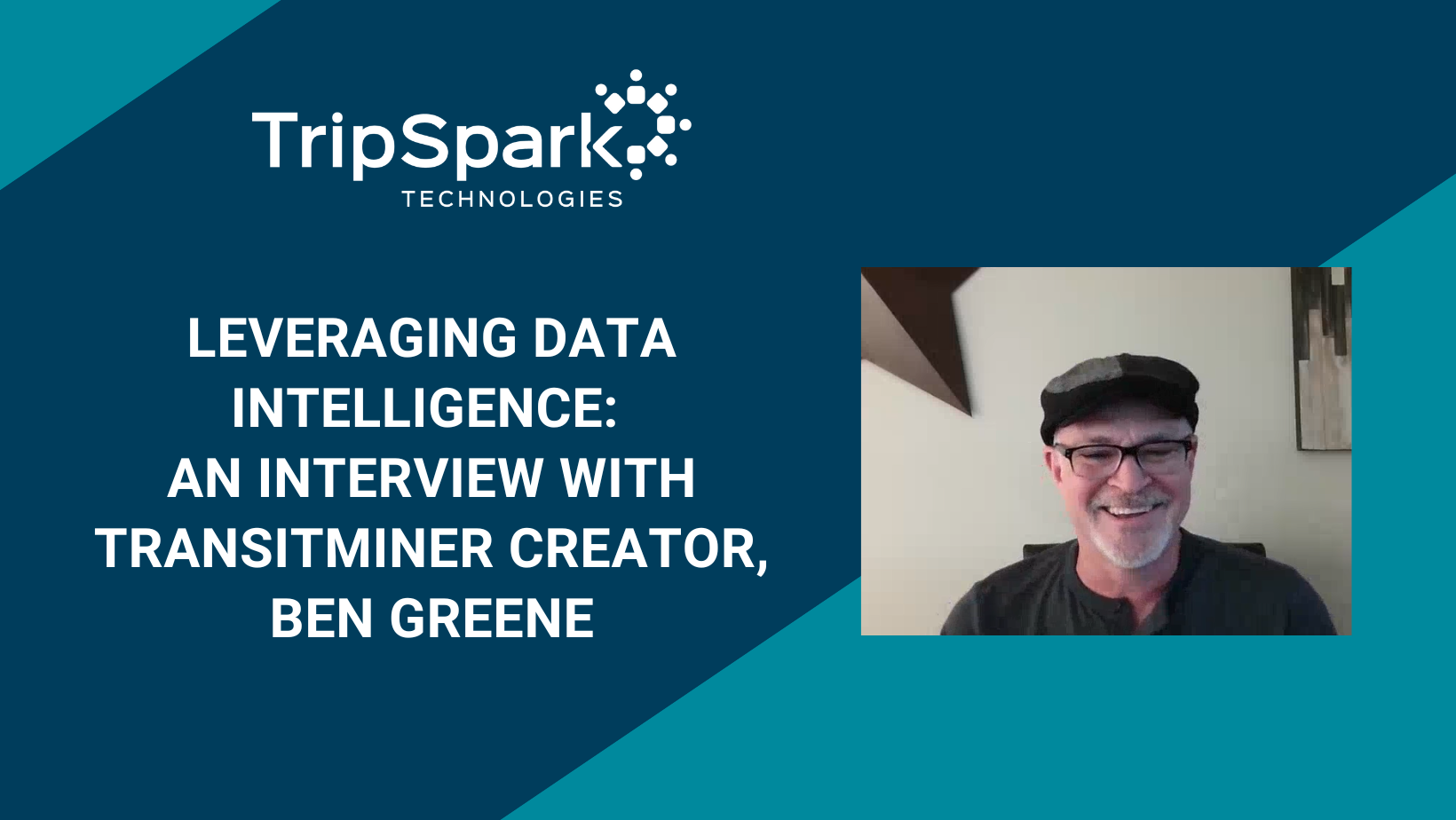Leveraging Data Intelligence: An Interview with TransitMiner Creator, Ben Greene

Ben Greene has over 30 years of experience in software development, with a focus on creating innovative transit solutions. He is currently the CEO and creator of Pickled.App, a platform designed to help pickleball players organize games and tournaments.

As the visionary behind TransitMiner, a powerful business intelligence tool that enables real-time data monitoring and in-depth transit analysis, Ben has a deep understanding of the value of data-driven decision-making. His work has helped transit agencies transform raw data into actionable insights, improving operations and performance across the board.
Q: Ben, tell us about your career in public transportation.
I got my start in public transportation at 20 years old, back when I couldn’t even rent a car for work trips. I stumbled into the industry after answering a job ad in the newspaper, and things took off from there. My career progressed quickly thanks to some key people who believed in me early on. At the time, I was a young father supporting a young family. Although I started out in administrative roles, my knack for the technical became apparent—that’s where the opportunities were. The industry was beginning its shift from rubber band boards and sticky notes to computers and automation, so it felt like fate.
Once I transitioned to the technical side, everything just clicked. It was a natural fit, like a fish taking to water. I was fortunate to have incredible mentors who shaped my career. Pam Rodriguez, the general manager in Reno/Sparks for CityLift, gave me one of my first big breaks. Later, I learned a tremendous amount from Marsha Moore, a major figure in the industry who founded the early PASS system, which eventually merged with Trapeze in the mid-90s. Another pivotal mentor was John Monson, an early trailblazer in contracted management. Between Marsha and John, I gained invaluable insight into transit technology and the business side of contracting with agencies and municipalities.
So, what started as a chance opportunity more than 30 years ago turned into a lifelong career, and I couldn’t be more grateful for the people who helped guide me along the way.
Q: What inspired you to create TransitMiner?
I saw a clear need in the industry for a solution that could bridge the gap between the canned reports provided by scheduling software and the custom reports transit agencies were developing in-house. There’s a significant space between those two extremes. Something that could extend the reporting capabilities of existing scheduling systems while being flexible enough to integrate data from multiple backend systems.
TransitMiner was designed to fill that gap by providing a standardized format and interface for reporting across different platforms. One of its key strengths is its ability to work with various data sources and deliver a unified, consistent view of transit operations.
Q: Who would benefit from using TransitMiner?
When building TransitMiner, I had four key groups in mind: municipalities, executive management, operations managers, and dispatchers.
Municipalities and transit agencies needed a reliable way to track performance metrics and funding. They needed to be accountable—to their board members, to their stakeholders, and ultimately, to the public. The challenge was that many agencies were manually running large batches of reports and summarizing the data in Excel. TransitMiner was designed to eliminate that time-consuming process by offering high-level performance summaries while also allowing agencies to drill into the details when needed. With TransitMiner, they could go from a broad overview to pinpointing specific issues with just a few clicks.
On the contractor side, executive management needed quick access to high-level dashboards and key performance indicators (KPIs). Their focus was often on tracking costs and navigating the incentives and penalties built into contracts. The goal was to give them a tool to monitor the most critical KPIs, while also enabling a deeper dive into the data as needed. It was about striking the right balance—presenting actionable insights in an easy-to-use interface.
Operational management and dispatchers are where my heart really lies. Along with drivers, dispatcher are the ones on the ground, making real-time decisions and ensuring that transit operations run smoothly. I wanted to give them tools to help them be more proactive, especially when things start to go off track in terms of service on-time performance. In transit, you’re often dealing with conflicting priorities—balancing service hours, miles, and on-time performance—and that’s a tough job.
TransitMiner was designed to show operations staff exactly where service exceptions are happening right now and provide tools to course-correct in real-time. Whether it’s a delay, a missed stop, or something else affecting service, the idea was to give them the information they need to act fast and keep things running smoothly.

Q: What benefits would transit agencies gain from using a business intelligence tool?
The possibilities of leveraging data effectively are practically limitless. With a tool like TransitMiner, agencies can not only react to real-time issues like service delays or missed stops but also optimize routes and improve overall performance.
Beyond the day-to-day operations, it helps them plan smarter for the future. Whether it’s making better staffing decisions, figuring out where and when to allocate resources, or identifying areas for service expansion, having the right data at their fingertips can make a world of difference.
I also wanted to give agencies a way to evaluate the impact of specific factors, like trip cancellations or excessive driver wait times, and use that insight to drive meaningful policy changes. Too often, agencies are stuck reacting to problems without the tools to understand why they are happening. The goal with TransitMiner was to turn raw data into actionable information that helps agencies make decisions that have real, measurable results.
Q: What risk do agencies take using manual methods of data analytics and reporting?
It’s 2024, and yet many agencies are still relying on spreadsheets. In my opinion, one of the biggest risks is data integrity. With manual data manipulation, errors inevitably creep in—and often go unnoticed. These errors can impact critical metrics like on-time performance or billable hours and miles, which in turn affect key decisions and policies.
When agencies depend on manual systems, there’s an inherent risk of significant data integrity issues. And if the data is flawed, it leads to poor decisions about how to allocate resources and, potentially, to misguided policies. It becomes a domino effect, where one small error can cascade into much larger problems.
TransitMiner addresses this with a sophisticated tool we call the “Oops Report”—a silly name that ended up sticking but a powerful feature. The Oops Report highlights specific data issues that could be skewing important metrics, whether it’s revenue miles, on-time performance, or any other key indicator. The idea is simple: agencies can review these errors, make targeted corrections, and immediately see the impact. For example, if an odometer reading was transposed on the first pick-up for route one, correcting that data point removes the error from the report, ensuring mileage calculations are as accurate as possible.
In short, the biggest risk of using manual systems is bad data. And when bad data drives critical decisions, it can have lasting negative effects.
Q: What types of data can TransitMiner process and analyze?
TransitMiner primarily focuses on scheduling data, vehicle GPS data, and passenger information—essentially, the core elements of transit operations. But its capabilities don’t stop there. The data processed by TransitMiner can be integrated with other in-house systems, such as vehicle maintenance platforms, driver payroll systems, CRMs, or financial systems. It’s designed to serve as a flexible bridge, helping agencies consolidate data from different sources.
One feature I feel is underutilized is TransitMiner’s ability to provide backend data feeds for other systems. Think about having all this information— from Novus and other systems but merged with a standardized format that makes it easy to consume elsewhere. TransitMiner has a universal schema that can handle most, if not all, transit operations data, making it incredibly versatile. Agencies can export that standardized data and leverage it however they need, whether for internal analytics or external reporting.

Q: Describe TransitMiner’s real-time capabilities.
TransitMiner has dedicated dashboards for real-time monitoring, offering insights into what’s happening now and what’s likely to happen in the near future. For example, it can show trips that are projected to be late an hour or more ahead, giving agencies the chance to take proactive steps like moving trips from one route to another to avoid delays.
Another real-time feature is the ability to filter and identify vehicles that are idle and available for service, meaning, they are in-service but not in traffic, on a scheduled break, or a lunch period. This helps agencies quickly understand whether there might be an operational issue that needs attention or someone available to cover trips.
TransitMiner’s real-time capabilities also include map-based displays that allow dispatchers to see routes in progress, identify gaps or slack time in the schedule, and spot drivers who may be underutilized. It’s all about giving agencies the tools to adjust schedules on the fly, keep services running smoothly, and maximize efficiency.
Q: How does TransitMiner differ from platforms like Novus or Routematch?
TransitMiner was designed to complement scheduling platforms like PASS, Novus, and Routematch by filling the gap between what those systems can do and what agencies often need but don’t have the resources to build. Scheduling platforms excel at core functions—scheduling, dispatching, AVL, and other operational tools—but their built-in reporting is usually limited to a fixed set of reports with some basic flexibility.
TransitMiner takes things further by providing a powerful layer of customizable reporting and analytics. It allows agencies to report on key metrics like on-time performance, service hours, and contract-specific calculations that aren’t always supported by off-the-shelf scheduling software. Whether calculating different metrics for various service types or tracking unique contract incentives and penalties, TransitMiner gives agencies the tools to get exactly the data they need without reinventing the wheel.
At its core, TransitMiner is about extending the life and utility of the data those platforms are already generating, turning it into actionable insights that can drive better decisions.
Q: How do you see TransitMiner evolving?
Even though I’ve spent the past five years outside the transit industry, I’m still a data nerd at heart. During that time, I’ve been involved in building different apps using modern languages and technologies that weren’t available back in 2011 when I created TransitMiner.
While TransitMiner has absolutely stood the test of time, I think there’s plenty of opportunity to evolve it further. On the front end, an updated UI could make the platform more intuitive and visually engaging for users. On the back end, I see huge potential in leveraging AI to enhance its capabilities—whether it’s automating error detection, improving data quality, or reducing the workload on agencies to clean and process their data.
With the technology available today, there’s a lot of low-hanging fruit that could make TransitMiner even more powerful. Imagine AI-driven insights helping agencies spot trends before they become issues or reducing the manual effort required to produce reports. The foundation is solid, and there’s a clear path to building on that foundation in ways that would provide even greater value to transit agencies.
Thank you, Ben! We learned so much about leveraging data intelligence and the operational efficiencies transit agencies can achieve when they use TransitMiner!

